1. Introduction to Smart Grids
The International Energy Agency (IEA) defines a Smart Grid as “an electricity network that uses digital and other advanced technologies to monitor and manage the transport of electricity from all generation sources in that (local) network to meet the varying electricity demands of end-users.” The US Department of Energy defines a Smart Grid as “the electricity delivery system, from point of generation to point of consumption, integrated with communications and information technology for enhanced grid operations, customer services, and environmental benefits.” Reinders et al. (in Reinders, 2019) cautions researchers that the term ‘Smart Grid’ was originally coined in 1966 to define a radio wave technology with little relation to electrical power distribution. One of the first appearances of the term in its current context is in the body of the 2007 Energy Independence and Security Act, a piece of legislation signed by the US Congress during the George W. Bush administration.
In June 2008, the US DOE’s National Energy Technology Laboratory (NETL) convened a diverse stakeholder meeting that established the seven principal characteristics that define the functions of a Smart Grid. The seven main tenets of a Smart Grid, the meeting established, were:
- Enabling active participation by consumers in demand response
- Accomodating all generation and storage options
- Enabling new products, services, and markets
- Providing power quality (PQ) for twenty-first century needs
- Optimizing assets and operating efficiently
- Self-healing from power disturbance events
- Operating resiliently against physical and cyber attack
Examination of these seven tenets makes evident that Smart Grid research and development is an inherently interdisciplinary endeavor. With this in mind, researchers and policymakers have proposed several frameworks that in one way or another facilitate their specific approach to this new concept. One simple example is the three-layer model that Reinders et al. (in Reinders, 2019) proposed as a basis for gathering knowledge and developing understanding about residential smart energy systems. While the model was originally developed with emphasis on domestic smart energy, its structure can be easily adapted and applied to wider Smart Grid research. As the name implies, the model is based on three “layers” (Figure 1): stakeholders, the market, and technology.
Figure 1. The three-layer model.
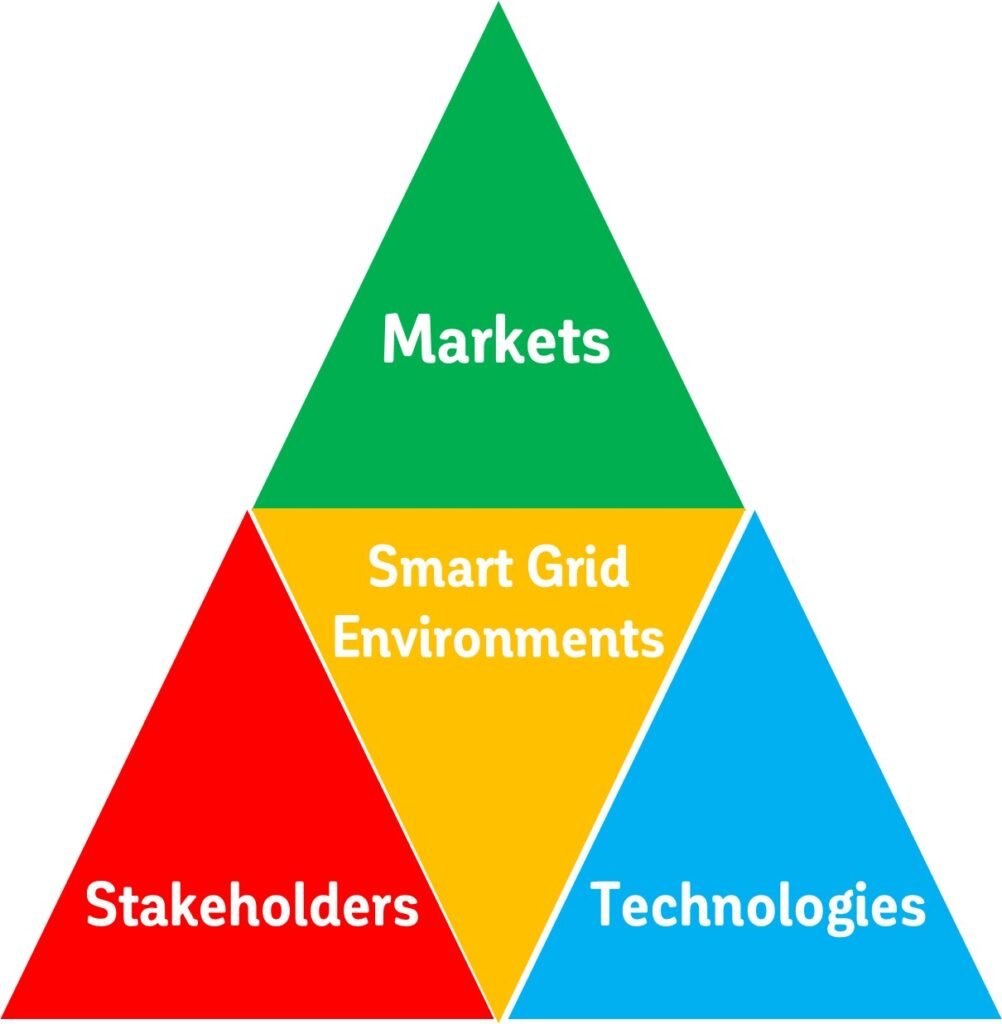
Stakeholders may be individuals or organizations, depending on the feature under consideration. Smart Grids have disrupted the traditional electricity consumer-utility dynamic and in the process gave rise to entirely new roles, such as the so-called ‘prosumer’, an end-user that consumes and (co-)produces energy.
Markets are the financial and business-related aspects of Smart Grids; they happen to be the one component that most significantly hinders uniform Smart Grid research on a global scale. Stakeholders such as consumers, utilities and governments exist in every electrical power infrastructure; the renewables with which these installations are powered, such as wind and solar, are often the same; the market structure and practices, however, vary widely from one place to the next, having achieved ever greater degrees of differentiation since the first power cables were put into operation about 130 years ago.
Then there’s technology, which encompasses the feats of engineering that enable society’s transition from an outdated grid based on one-way communications and largely electromechanical equipment to a modern topology endowed with two-way integration and fully digital solutions. Some of the various technologies that may come to constitute a Smart Grid are listed in Table 1.
Table 1. Categories of Smart Grid and related technologies. Adapted from Reinders et al. (in Reinders, 2019).
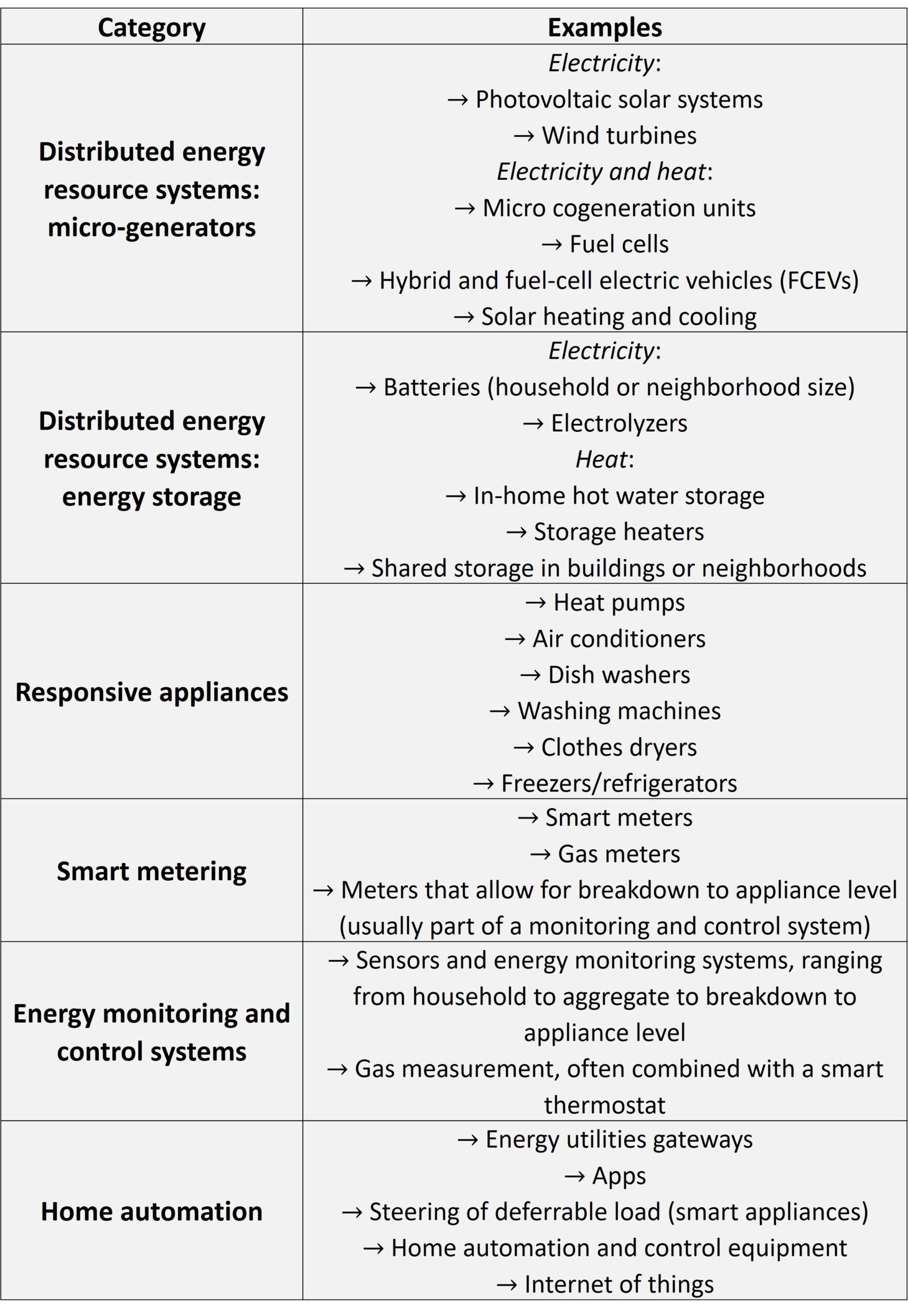
While the implementation of Smart Grids will entail a drastic transformation of several aspects of electricity generation, transmission, and distribution, it is erroneous to view this process as a complete replacement of old technologies with new, futuristic ones. In actuality, even the most disruptive Smart Grid concepts ultimately rely on the same “heavy metal” instrumentation that has been the mainstay of electric delivery systems for over a century: transmission lines, distribution feeders, switches, breakers, transformers, and so on. What some recent innovations do, as Borlase (in Borlase, 2013) points out, is provide this “dumb” part of the grid with technology that improves monitoring, control, and protection. Further, some equipment may acquire new functions (or lose old ones) in the power T&D dynamics; smart grid substations, for one, will move beyond basic protection and traditional automation schemes to bring complexity around distributed functional and communications architectures, more advanced local analytics, and the management of vast amounts of data (Borlase, in Borlase, 2013).
After Lamprinos et al. (in Sun et al., 2016), a brief comparison between existing grid and Smart Grid is provided in Table 2.
Table 2. Comparison between existing grid and Smart Grid.
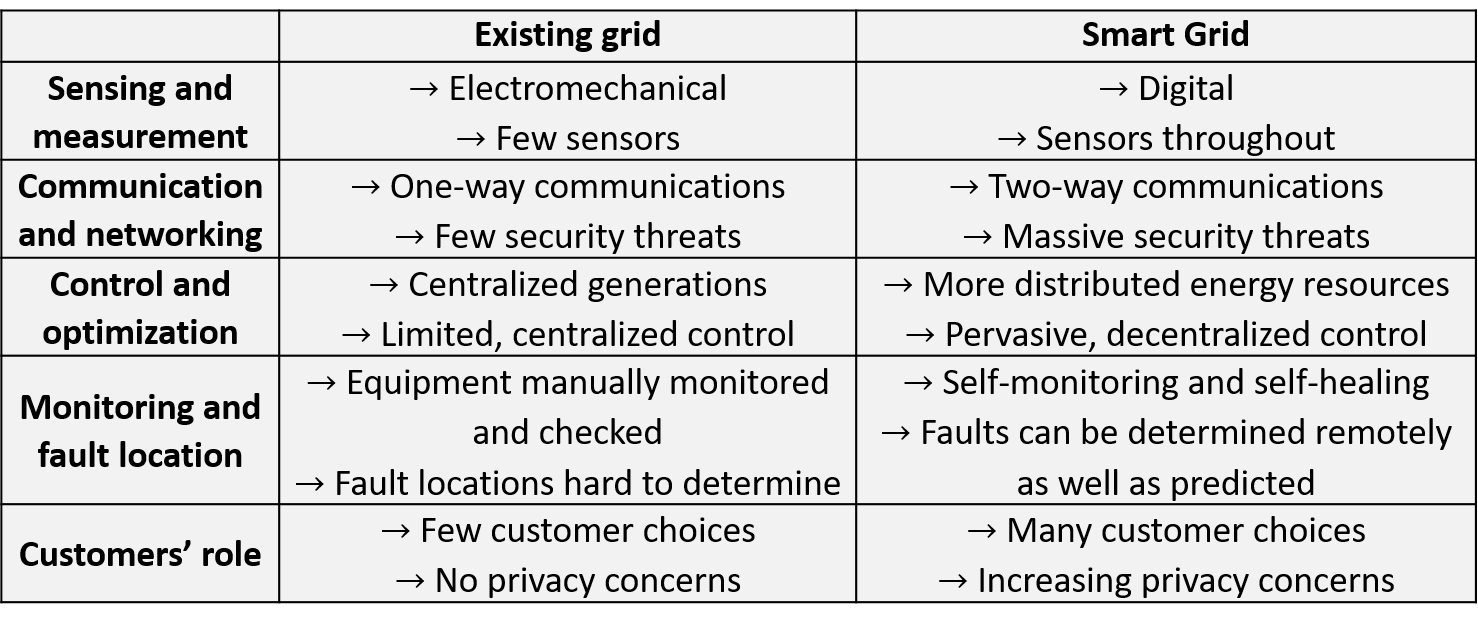
2. Communications in the Smart Grid
The communication system connects various parts of the Smart Grid architecture for real-time control, monitoring, and data utilization. Integrated communication is the connector of all Smart Grid technologies. The communication infrastructure of the Smart Grid is predicated upon three network levels: Home Area Network (HAN), Neighborhood Area Network (NAN), and Wide Area Network (WAN).
A HAN is installed and operated in a small area (tens of meters) and has a lower transmission data rate of hundreds of bits per second. HAN consists of a broadband internet connection used to communicate and share the data between devices across a network connection and smart meters. Several technologies are available for in-home communication, but most domestic applications rely on ZigBee. In commercial buildings, BACnet is the prominent communication protocol.
A NAN covers a few hundred meters and gathers information from HANs, supplying local data centers with information for storage and analytics. The NAN has a 2 Kbps data rate. Different technologies can be used to implement a NAN network, including Power Line Communication (PLC), Wi-Fi, and Cellular.
Lastly, a WAN covers tens of kilometers and integrates several NANs. Communication between Smart Grid generation, transmission and distribution infrastructure is made possible by WANs. A number of technologies can be employed to achieve exchange of information in WAN, including ZigBee, Wireless Local Area Network (WLAN), Cellular networks, and PLC.
3. Smart metering
In the second half of the 1980s, several electricity companies in developed countries implemented automated reading of the power consumption meters installed in their customers’ premises. Adoption of that approach was driven by the need to lower the significant costs of in-site reading, reflecting high labor costs in rich countries (World Bank, 2011). Those solutions, referred to as automated meter reading (AMR), saved some money to utilities but did little to change the consumer-producer dynamic that underpins electrical power T&D. A more drastic transformation had to wait until the 1990s and 2000s, when AMR evolved to smart metering, an advanced system of meter read collection that has become a hallmark of Smart Grid infrastructure. While there are various definitions for “smart meter” in the literature, World Bank (2011) mentions three features that seem to occur in most of them:
- Smart meters generally include systems that measure consumption during specific time periods (e.g., every 15 minutes, every hour) and communicate it to utilities at least daily.
- Smart meters are endowed with a one-way communications channel that enables the utility to obtain meter reads on demand, to ascertain whether electricity is flowing through the meter and into premises, and to issue commands to the meter such as disconnecting.
- Smart meters are linked to some device that informs the user in real time about current use, consumption during a specific period, consumption trends, and/or other information designed to help the customer manage electricity costs and usage.
A smart meter-endowed electrical grid is said to constitute a advanced metering infrastructure, or AMI. This term was coined in a 2002 California Public Utilities Commission (CPUC) proceeding and has since become synonymous with wide usage of smart meters (Borlase et al., in Borlase, 2013). Smart metering and AMI makes possible functionalities such as:
- Collect, store, and report users’ energy consumption data for any needed periods.
- Enhance energy diagnostics from detailed load profiles.
- Obtain location and degree of outages remotely.
- Provide the possibility for remote connection and remote disconnection.
- Allow identification of electricity losses and theft.
Each of these aspects of AMI come with their own individual technological requirements and have different implications for the power T&D dynamic. With regard to aspects 4 and 5, for example, smart metering systems are designed to improve processes within the utility company and reduce losses. However, there is a risk that existing nontechnical losses will not be corrected, or even that new sources of losses may be created during meter replacement. Bad asset management, for example with respect to the meter’s location and status problems, normally increase this risk. It follows that it may be appropriate to integrate smart meter systems with geographic information system (GIS) platforms so as to pinpoint the location of devices (Toledo, 2013).
Some of the benefits of AMI are summarized in Table 3.
Table 3. Benefits of Advanced Metering Infrastructure for suppliers and consumers.
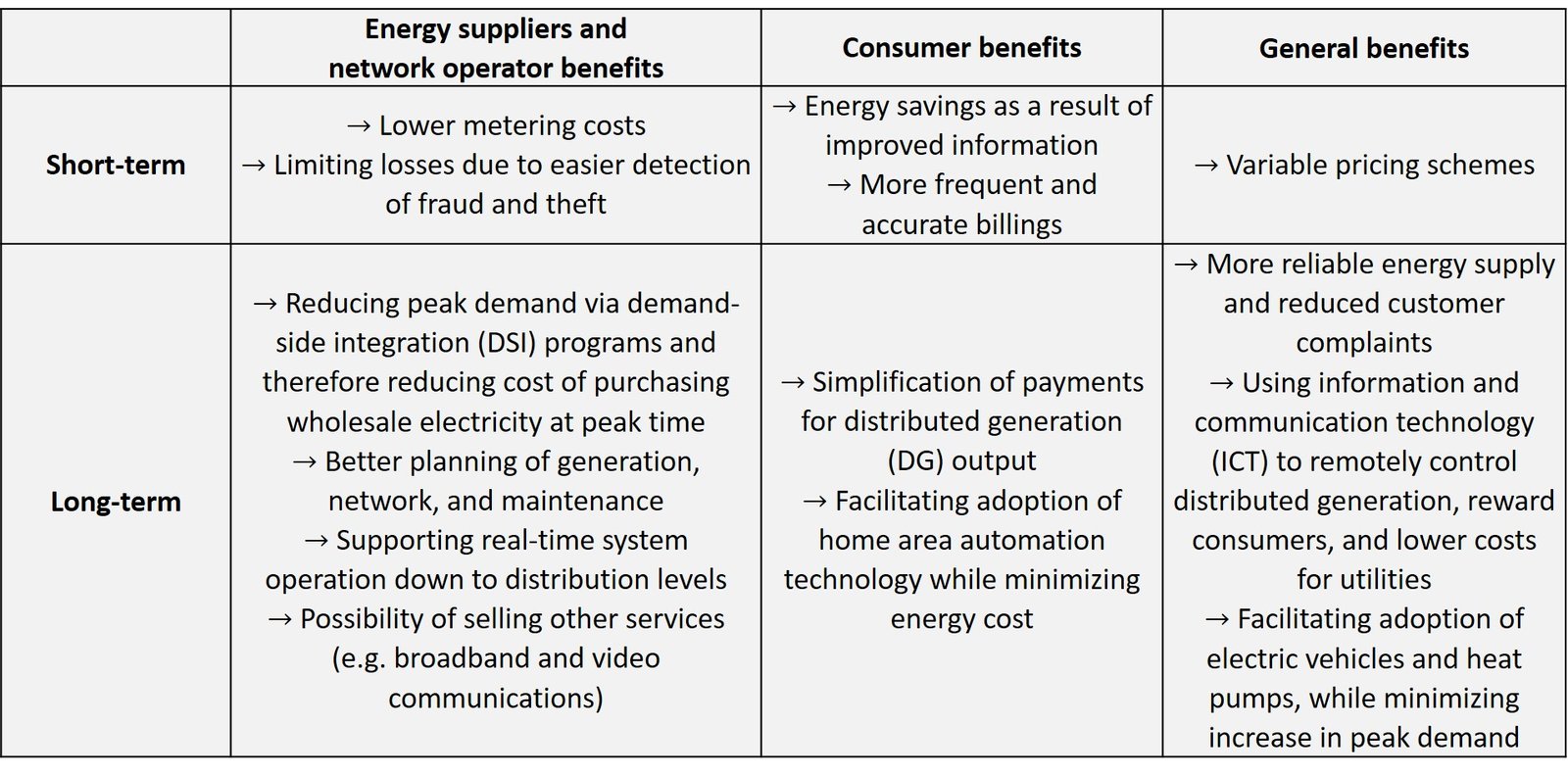
4. Demand response
Demand response (DR) is a reduction in load demand designed to respond to price signals or system dispatch instructions. DR programs have been used as resource options for balancing supply and demand by electric systems planners and operators since the 1970s. Recently, resurging interests in DR technologies have been motivated by advancements in information and communication technologies and by the wide deployment of sensors; in other words, DR research and policies have rekindled due to the introduction of Smart Grid technologies. Coincident with the advent of innovative technology is the realization that reliable and secure electric grid operation can no longer be enforced by investments on the supply side of electrical power services alone (Du et al., 2019).
Demand Response has been juxtaposed to Smart Grid infrastructure but actually precedes it by decades. The first effort to implement DR dates back to the second half of the 1970s, when the oil embargo raised energy prices and the accident at Three Mile Island raised concerns on the viability of nuclear power. Between 1975 and 1976, the Federal Energy Administration established a number of pricing experiments to assess the impact of demand management on load patterns. Peak reductions as high as 40% were achieved, highlighting the advantage of time-of-use pricing (Du et al., 2019). However, it was only in the early 2000s that a combination of technological progress and regulatory environment brought the resurgence in DR that remains active to this day.
Effective implementation of DR needs an advanced ICT (Information and Communication Technology) infrastructure and good knowledge of system loads, but the electromechanical meters that are employed in most households and many installations obviously do not lend themselves to two-way communication or real-time load information updating. These limitations can be easily overcome by the implementation of smart metering, which gives utilities the capacity of continuously monitoring loads in the AMI network, interact with end-users’ electrical installations in real time, and respond to adverse scenarios with unparalleled speed and flexibility.
DR implementations are often divided into two categories: price-based and incentive-based. Price-based DR achieves demand-side integration via mutable price schemes and can be further divided into three subcategories (Ekayanake et al., 2012):
- Time of use (ToU): ToU rates use different unit prices for different time “blocks,” usually predefined for a 24-hour day. ToU rates reflect the cost of generating and delivering power during different time periods.
- Real-time pricing (RTP): The electricity price provided by RTP rates typically fluctuates hourly, reflecting changes in the wholesale energy price. Customers are usually notified of RTP prices on a day-ahead or hour-ahead basis.
- Critical peak pricing (CPP): CPP rates are a hybrid price-based category that combine ToU and RTP. The basic rate structure is ToU, but the normal peak price is replaced by a much higher CPP price under predefined trigger conditions, such as when a system is suffering from some operational problem or the supply price is very high.
Then there’s incentive-based DR, which stimulates end-users to shift their usage patterns by methods that go beyond mere flexible pricing. Some examples of incentive-based DR include:
- Direct load control (DLC): Customers’ electrical appliances, such as air conditioners and heaters, are controlled remotely by the program operator on short notice. DLC is primarily offered to residential or small commercial customers.
- Interruptible/curtailable service: Users agree to curtail loads during contingencies in exchange for rate discounts or bill credits. Users who do not curtail may receive penalties. Curtailable-service incentives have traditionally been offered to large industrial or commercial customers.
- Demand-side bidding/buyback programs: Customers offer bids for curtailment based on wholesale electricity market prices. This is mainly directed at large customers, but small customers may also participate by tasking so-called aggregators to aggregate loads and bid in the electricity market on their behalf.
- Ancillary services: Ancillary services are services needed to support the transmission of energy to loads while maintaining reliable operation of the transmission systems. An ancillary service is characterized by response time, duration of the response, the time to full response, and how often the product is called (whether they are deployed continuously or only under contingency conditions). Ancillary services in power T&D actually predate modern demand-side integration practices, but can be combined with DR and other Smart Grid technologies for better reliability and control (Du et al., 2019).
Figure 2 illustrates the various time scales on which the DR categories mentioned above operate.
Figure 2. The different time scales of demand response. Adapted from Ekayanake et al. (2012).
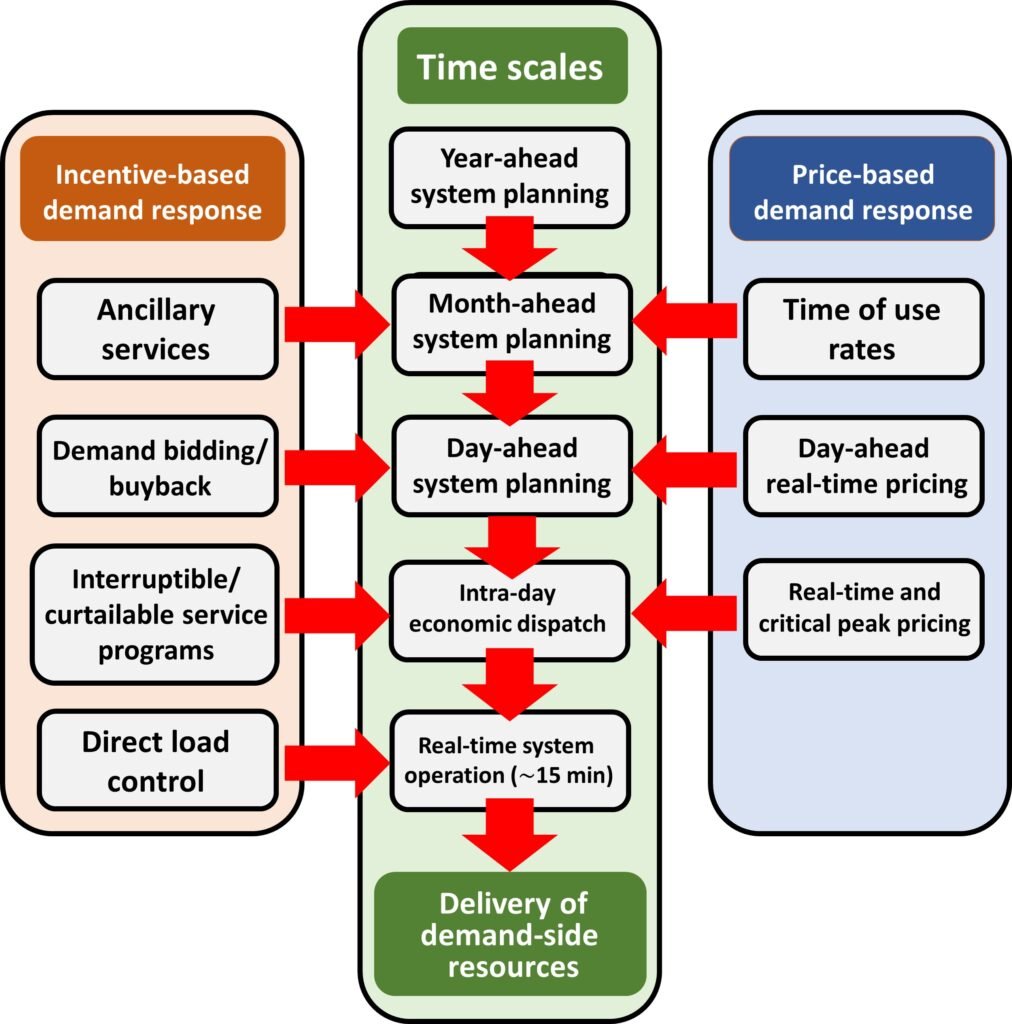
Demand response achieves at least two important benefits: peak load reduction and congestion management.
The most immediate benefit of DRs is peak load reduction. DRs provide consumers an opportunity to actively contribute to reliable, uninterrupted operation of the electric grid by shifting their electricity usage away from peak periods in exchange for benefits. Peak loads are undesirable for a number of reasons, including the fact that losses are greater under heavy loading conditions due to a nonlinear quadratic dependence on currents. Most importantly, however, capital investments may be driven up by preparedness against peak loads. Many components of generation, transmission and distribution infrastructure are designed with ever greater peak loads in mind, and to accommodate such loads is to deploy costly infrastructure that may not be needed for most of the year. A demand-response-integrated Smart Grid may enable utilities to do away with some of the infrastructure designed exclusively to withstand peak loads, or at least to reduce overall underutilization.
Congestion management is a common problem in power systems and becomes more pronounced in deregulated and competitive markets. Distribution lines are often driven close to or even beyond their thermal limits in order to satisfy the increased electric power consumption or deal with increased unplanned power exchanges. If the power flows were not controlled, some lines in particular paths may become overloaded, a phenomenon called congestion. Congestion management in power lines is difficult for a number of reasons. For one, distribution networks are operated with radial topology, which leaves no alternative path to circumvent interrupted power flow in the event of outages. Further, overloading of parts of the distribution network may not coincide with peak loads, which makes it difficult to predict which lines are most susceptible and which kinds of load are most dangerous. Demand response can better account for this uncertainty by rescheduling and postponing load demand to reduce the congested power flow. Load resources involved in DR are flexible, and temporal manipulation of such loads enables operators to shift shutdown events, if they occur at all, to periods that may not even be noticed by end-users.
5. Privacy risks in the Smart Grid
Smart meters measure consumption data frequently, often once at every interval of 5 to 60 min depending on the technology (Mohassel et al., 2014). As noted in Herold and Hertzog (2015), a detailed sense of the activities within a house or building can be derived from equipment electricity signatures, individual appliance usage data, time patterns of usage, and other data. Especially when collected and analyzed over a period of time, this information can provide a basis for potentially determining occupant activities and lifestyle, including forecasts on the number of individuals at a premise, when the location is unoccupied, and sleep and work schedules. Furthermore, some aspects of SG infrastructure make them more vulnerable than a typical technology with support to wireless communications. For one, smart meters are installed in easily reachable locations and can be easily tampered with. If physical access is not possible, hackers may still access one of the systems that have access to metering data at the utility end, which may be numerous and thus require coordinated security policies and technologies on part of power providers. Lastly, some Smart Grid infrastructures rely on public communication services such as Cellular networks, which have limited security compared to networks especially designed for certain purposes.
Consumers who fear that their power consumption data may end up in the hands of hackers, or those that believe that utilities are offering them a poor service because of their power consumption patterns, may well object to have their homes wired to a Smart Grid. It follows that protection of Smart Grid users’ privacy is not only a legal requirement, but also a prerequisite for adhesion to this new technology. Governments and utility companies play a crucial role in instilling in consumers the notion that the benefits of SG far outweigh the risks. Researchers, in turn, are tasked with developing cutting-edge safety algorithms and cryptography that make Smart Grid networks as secure as the most advanced communication platforms of our age. Research of this nature is an active topic and has filled entire volumes (e.g., Skopik and Smith, 2015).
References
Download reference list here.




